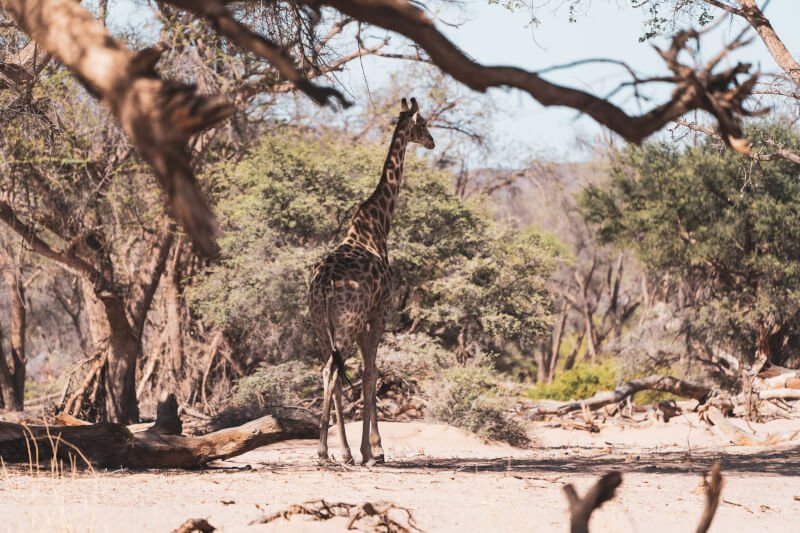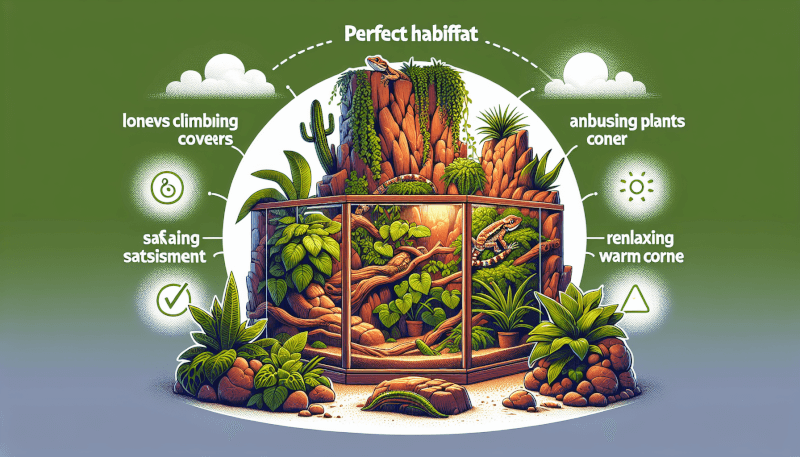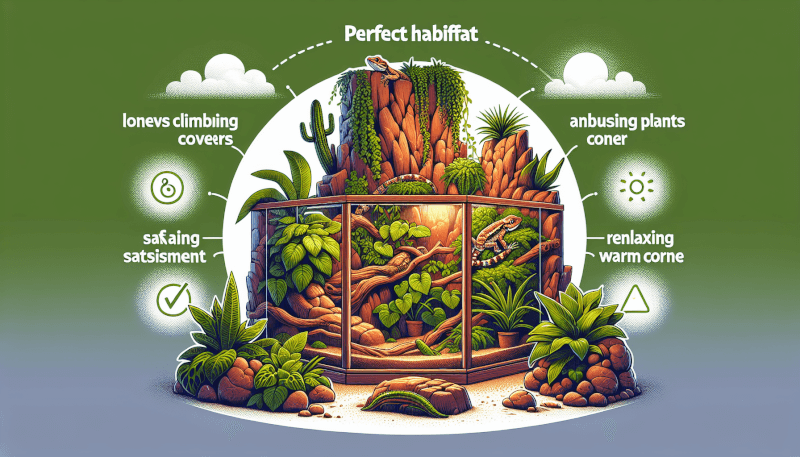Have you ever wondered how to create the perfect living environment for your beloved reptile? Look no further, because in this article, we will guide you through the process of creating the ideal habitat for your scaly friend. From the temperature and humidity levels to the appropriate substrates and decorations, we’ve got you covered. Get ready to provide your reptile with a comfortable and stimulating space they can call home. Let’s dive in!
Choosing the Right Cage or Enclosure
When it comes to creating the ideal habitat for your reptile, choosing the right cage or enclosure is crucial. The size and space requirements, as well as the materials and construction, are important factors to consider. Accessibility and security are also key considerations in providing a safe and comfortable environment for your scaly friend.
Size and Space Requirements
The first thing you need to keep in mind when selecting a cage or enclosure is the size and space requirements for your reptile. Different species have different needs, so it is important to research the specific requirements for your pet. Consider the adult size of your reptile and choose a cage or enclosure that allows them to move around freely and comfortably.
Materials and Construction
The next factor to consider is the materials and construction of the cage or enclosure. Reptiles have specific needs when it comes to temperature and humidity, so it is important to choose a material that can provide insulation and regulate these factors effectively. Glass terrariums and PVC cages are popular choices for their durability and ability to maintain a stable environment for reptiles.
Accessibility and Security
Accessibility and security are also important aspects to consider when choosing a cage or enclosure. Your reptile should be able to easily access the different areas of their habitat, such as the feeding and hiding spots. Additionally, make sure that the enclosure has a secure locking mechanism to prevent any escape or unauthorized access. It is always better to be safe than sorry when it comes to the well-being of your reptile.
Providing the Appropriate Lighting and Heating
Reptiles have specific lighting and heating needs that must be met to ensure their overall well-being. Understanding these needs, selecting the right light sources, and using heat sources safely are all crucial in creating the ideal environment for your scaly friend.
Understanding Reptile Lighting Needs
Proper lighting is essential for reptiles as it helps regulate their biological processes, including metabolism and Vitamin D synthesis. Different reptiles have different lighting requirements, so it is important to research the specific needs of your pet. Most reptiles require a combination of UVA and UVB lighting to mimic natural sunlight.
Selecting the Right Light Sources
When selecting light sources for your reptile’s habitat, it is important to choose bulbs that provide the appropriate spectrum of light. Full-spectrum UVB bulbs are commonly used to provide the necessary UVB radiation for reptiles. Additionally, providing a heat source along with the lighting can help create a basking spot for your reptile to regulate their body temperature.
Using Heat Sources Safely
Using heat sources safely is of utmost importance to prevent any accidents or harm to your reptile. It is essential to provide a heat source that is appropriate for your reptile’s specific needs. This can be achieved through the use of under-tank heat pads, heat lamps, or ceramic heat emitters. Always ensure that the heat source is properly secured and that your reptile cannot come into direct contact with it to avoid burns.

Setting Up the Proper Temperature Gradient
Creating a proper temperature gradient within your reptile’s habitat is crucial for their overall health and well-being. By providing warm and cool zones, monitoring and adjusting temperatures, as well as preventing overheating or cooling, you can ensure a comfortable environment for your scaly friend.
Creating Warm and Cool Zones
Reptiles, like many animals, require a range of temperatures to properly regulate their body temperature. By creating warm and cool zones within the habitat, your reptile will have the opportunity to move between different temperature areas as needed. This can be achieved by providing a heat source in one area of the habitat and ensuring that the opposite side remains cooler.
Monitoring and Adjusting Temperatures
Regularly monitoring and adjusting temperatures is essential to maintain the proper temperature gradient within your reptile’s habitat. The use of thermometers and thermostats can help you accurately measure and control the temperature in different areas of the enclosure. It is important to research the specific temperature requirements of your reptile and make necessary adjustments accordingly.
Preventing Overheating or Cooling
Preventing overheating or cooling is crucial in maintaining the health and well-being of your reptile. It is important to ensure that the heat source is not too close to your reptile’s basking spot, as this can cause overheating. Similarly, make sure that the cooler side of the habitat remains within the appropriate temperature range to prevent your reptile from becoming too cold.
Maintaining Optimal Humidity Levels
Proper humidity levels are essential for reptiles, as they help with shedding, respiratory health, and overall hydration. Understanding the importance of humidity, choosing the right humidity range, and using humidifiers or mist systems are all important aspects of creating the ideal habitat for your scaly friend.
Understanding the Importance of Humidity
Humidity plays a crucial role in the health and well-being of reptiles, as it helps maintain proper hydration and aids in the shedding process. Different reptiles have different humidity requirements, so it is important to research the specific needs of your pet. Inadequate humidity can lead to dehydration, respiratory problems, and difficulty in shedding.
Choosing the Right Humidity Range
Choosing the right humidity range for your reptile is important to ensure their optimal health. Research the specific humidity requirements of your pet and provide an environment that closely mimics their natural habitat. This can be achieved through the use of humidifiers, mist systems, or by manually misting the enclosure with water. It is essential to regularly monitor humidity levels and make adjustments as needed.
Using Humidifiers or Mist Systems
Humidifiers and mist systems can be effective tools in maintaining proper humidity levels within your reptile’s habitat. These devices help add moisture to the air, creating a more humid environment for your scaly friend. When using humidifiers or mist systems, it is important to ensure that the enclosure does not become too damp, as this can lead to the growth of harmful bacteria or fungi.

Creating a Suitable Substrate
Choosing the right substrate for your reptile’s habitat is essential for their comfort and overall health. Different reptiles have different substrate requirements, so it is important to research the specific needs of your pet. Considerations for digging, burrowing, or climbing should also be taken into account to provide the ideal substrate for your scaly friend.
Types of Substrates for Different Reptiles
There are various types of substrates available for reptiles, each catering to the specific needs of different species. Some common substrates include reptile carpet, calcium sand, coconut husk, and cypress mulch. Research the specific substrate requirements for your reptile and choose one that is safe, non-toxic, and allows for natural behaviors such as burrowing or digging.
Considerations for Digging, Burrowing, or Climbing
Many reptiles have natural behaviors such as digging, burrowing, or climbing. It is important to provide a substrate that allows for these natural behaviors and promotes the overall well-being of your pet. For reptiles that like to dig or burrow, choose a substrate that is loose and provides adequate depth. If your reptile enjoys climbing, consider incorporating branches or logs as part of their habitat.
Avoiding Harmful Substrates
Some substrates can be harmful or toxic to certain reptiles. It is important to avoid substrates such as cedar chips or certain types of sand that can cause respiratory issues or digestive problems. Always research and choose substrates that are safe and appropriate for your reptile’s specific needs to ensure their overall health and well-being.
Providing Hiding Places and Shelter
Hiding places and shelter are essential for reptiles, as they provide a sense of security and aid in reducing stress. By providing both natural and artificial hiding spots, different hides for different times, and promoting a sense of security, you can create the ideal habitat for your scaly friend.
Natural and Artificial Hiding Spots
Reptiles require hiding places to feel secure and safe within their habitat. Providing both natural and artificial hiding spots allows your pet to choose the environment that suits them best. Natural hiding spots can include rock formations, driftwood, or plants, while artificial hides can be purchased from pet stores and come in various sizes and shapes.
Different Hides for Different Times
Reptiles have different behaviors and preferences when it comes to hiding. Some reptiles may prefer a darker and more enclosed hide during the day, while others may prefer a more open and airy hide. It is important to provide a variety of hides within your reptile’s habitat to accommodate their different needs throughout the day, as well as during shedding or breeding periods.
Promoting a Sense of Security
Creating a sense of security is crucial for the overall well-being of your reptile. This can be achieved by placing hides or shelter in strategic locations within the habitat, ensuring that your reptile feels protected and safe at all times. Additionally, minimizing any sudden loud noises or disturbances near the habitat can also help promote a sense of security for your scaly friend.

Setting Up the Right Decor and Furniture
Decor and furniture play an important role in creating a stimulating and enriching environment for your reptile. By selecting suitable branches, rocks, or logs, creating climbing and basking opportunities, and including varying levels and textures, you can provide the ideal habitat for your scaly friend.
Selecting Suitable Branches, Rocks, or Logs
Providing suitable branches, rocks, or logs within your reptile’s habitat can help replicate their natural environment. These natural elements provide climbing opportunities and can also serve as basking spots for your reptile to regulate their body temperature. When selecting these items, ensure that they are securely placed and cannot fall or cause any harm to your pet.
Creating Climbing and Basking Opportunities
Reptiles, especially arboreal species, have a natural inclination to climb. By incorporating branches or climbing structures within their habitat, you can provide them with the opportunity to engage in this behavior. Additionally, creating basking spots with rocks or logs that are heated by a heat source can help your reptile regulate their body temperature effectively.
Including Varying Levels and Textures
Including varying levels and textures within your reptile’s habitat can help create a stimulating and enriching environment. This can be achieved by adding branches and rocks of different heights, as well as incorporating different substrate textures such as moss or sand. Providing these varied elements stimulates your reptile’s natural behaviors and keeps them mentally and physically engaged.
Establishing the Proper Feeding and Watering Stations
Establishing the proper feeding and watering stations within your reptile’s habitat is essential for their overall health and well-being. By choosing the right food and water containers, positioning the feeders and water bowls appropriately, and preventing contamination and spillage, you can ensure that your scaly friend receives the nutrition and hydration they need.
Choosing the Right Food and Water Containers
Choosing the right food and water containers is important to ensure that your reptile has easy access to their meals and remains hydrated. Reptiles have different feeding preferences, so it is important to research the specific dietary requirements of your pet. Ensure that the containers are secure and cannot be tipped over easily, preventing any spillage or contamination.
Positioning the Feeders and Water Bowls
Positioning the feeders and water bowls appropriately within your reptile’s habitat is essential for their ease of access. Place the food and water containers in easily reachable areas, ensuring that your pet does not have to navigate obstacles to reach them. Additionally, it is important to regularly clean and sanitize the containers to prevent the growth of harmful bacteria.
Preventing Contamination and Spillage
Preventing contamination and spillage is crucial to maintain the hygiene and health of your reptile’s habitat. Clean any spilled food or water immediately to avoid the growth of bacteria or other pests. It is also important to regularly clean and disinfect the food and water containers to prevent the transmission of any diseases or parasites.

Maintaining Cleanliness and Hygiene
Maintaining cleanliness and hygiene within your reptile’s habitat is crucial for their overall health and well-being. Regular spot cleaning and waste removal, disinfecting and sanitizing the habitat, and preventing the growth of harmful bacteria are all important aspects of providing an ideal environment for your scaly friend.
Regular Spot Cleaning and Waste Removal
Regular spot cleaning and waste removal are essential in maintaining a clean and hygienic environment for your reptile. Remove uneaten food, feces, and any soiled substrate on a daily basis to prevent the growth of bacteria or parasites. Regularly inspect the habitat for any signs of illness or injury and address them promptly.
Disinfecting and Sanitizing the Habitat
Periodically disinfecting and sanitizing the habitat is important to prevent the transmission of diseases or parasites. Use reptile-safe disinfectants and follow the instructions carefully to ensure that the habitat is properly cleaned. Avoid using any harsh chemicals that may be toxic to your reptile, and always rinse thoroughly after disinfecting.
Preventing the Growth of Harmful Bacteria
Preventing the growth of harmful bacteria is crucial for the health and well-being of your reptile. Maintaining proper temperature and humidity levels, regular cleaning and waste removal, as well as using reptile-safe disinfectants, are all important in preventing the growth of bacteria. It is also important to monitor your reptile for any signs of illness or infection and seek veterinary care if necessary.
Monitoring and Maintaining a Proper Environment
Monitoring and maintaining a proper environment for your reptile is an ongoing process. Using thermometers and hygrometers, regularly checking equipment and conditions, and making necessary adjustments are all important aspects of ensuring that your scaly friend’s habitat remains optimal.
Using Thermometers and Hygrometers
Using thermometers and hygrometers is essential in monitoring the temperature and humidity levels within your reptile’s habitat. It is important to place these devices in different areas of the enclosure to ensure accurate readings. Regularly check the readings and make any necessary adjustments to maintain the proper environment for your reptile.
Regularly Checking Equipment and Conditions
Regularly checking the equipment and conditions within your reptile’s habitat is important to ensure that everything is functioning properly. Inspect the heat sources, lighting fixtures, and any other equipment regularly for any signs of damage or malfunction. Additionally, check the overall condition of the habitat, including the cleanliness of the substrate and the health of your reptile, to address any potential issues promptly.
Making Necessary Adjustments
Making necessary adjustments to the habitat is an ongoing process as you learn more about your reptile’s specific needs and behaviors. Whether it is adjusting the temperature or humidity levels, changing the type of substrate, or adding or rearranging decor and furniture, it is important to be flexible and make changes as needed to create the ideal environment for your scaly friend.
In conclusion, creating the ideal habitat for your reptile requires careful consideration and planning. By choosing the right cage or enclosure, providing appropriate lighting and heating, establishing the proper temperature gradient, maintaining optimal humidity levels, selecting a suitable substrate, providing hiding places and shelter, setting up the right decor and furniture, establishing the proper feeding and watering stations, maintaining cleanliness and hygiene, and monitoring and maintaining a proper environment, you can ensure the health, well-being, and happiness of your scaly friend. Remember to always research the specific needs of your reptile and consult with a veterinarian or reptile expert for any specific care requirements. With the right habitat, your reptile will thrive and flourish in their new home.



